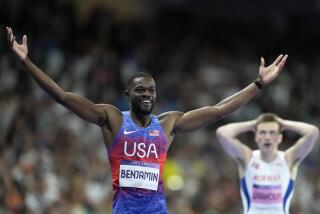Just Two for the Show : Not Getting Into Swim of Things Is Giving Biathletes a Bad Rap
- Share via
SAN DIEGO — Joel Thompson and Ken Souza are triathletes who can’t swim. At least not as well as they’d like.
Of course, they don’t go around touting their aversion to water. Instead they have become . . . biathletes.
The problem is that in the world of endurance sports, biathletes generally are regarded in a lesser light than triathletes, which tends to give biathletes somewhat of an inferiority complex.
Maybe that’s why, when asked how they are perceived by their triathlete brethren, Thompson answered, “Kenny and I have the rap of being good biathletes.”
It is considered by some to be a bad rap that Thompson didn’t always have . He originally started as a distance runner and later dabbled in triathlons. But his first taste of victory did not come until he entered a 1986 triathlon in Victoria, Tex. Because of stormy conditions along the Gulf of Mexico, the swim was canceled and replaced with another running leg. Thompson found his niche.
Souza, who like Thompson lives in Encinitas, still competes in triathlons, though not nearly as successfully as he does in biathlons.
It’s just a matter of buoyancy, or lack thereof.
“It is pretty much true,” Thompson said. “We are not good swimmers. We have a lot of recognition and acceptance as biathletes, but as far are triathlons go, we weren’t that good. Kenny, in particular, if he could swim, he could be one of the best triathletes.”
Instead he’s considered the best biathlete, and, for once, that ranking might mean something. This year, the sport has been infused with a $75,000-purse, 15-city tour.
And for now, Thompson and Souza are in line to stake the two biggest claims. They are the point leaders of the Coors Light Biathlon Series, which makes its next-to-last stop of the year Sunday in San Diego in a race beginning at 7 a.m. in the San Diego Jack Murphy Stadium parking lot.
A biathlon is a five-kilometer run, 30-kilometer bike race and another five-kilometer run, perfect for the endurance athlete who doesn’t want to hit the water until he showers.
Now about that inferiority thing. Biathletes also say that’s a bum rap, that their sport is indeed more physically taxing than triathlons.
The really tough part, they say, is the transition from running to cycling. This is because the initial run often turns into a sprint and leaves the competitors with little wind left for the bike ride.
Thompson uses the word anaerobic to describe the first leg of his sport. Unlike aerobic activity that increases the heart rate to a point where it pumps a large supply of oxygen to muscles, the 5,000-meter “sprint” is so demanding that participants actually create an oxygen deficit.
When one’s oxygen level is below empty, muscles tend to revolt at the thought of a 30-kilometer bike ride.
Even good triathletes who enter biathlons thinking they will get a break from their rigorous training find the run-bike transition especially difficult.
Just ask Colleen Cannon, the points leader in the U.S. Triathlon Series who entered a Coors Light Biathlon in Jacksonville, Fla., earlier this month. She lost by four minutes to biathlete Liz Downing.
“Triathletes just aren’t used to cycling hard after an anaerobic run,” Thompson said.
Said Brent Steiner of Tempe, Ariz., currently ranked third in the Coors Light Series: “Afterward, Colleen said that it was one of the toughest races she had ever been in. What Colleen found to be different (than triathlons) is that the first 5K is an all-out run.”
Despite this apparent hinderance, Souza expects more triathletes to cross over to biathlons, or at least for more endurance athletes to choose the upstart sport.
“There’s a lot of people out there who don’t like to swim,” he said. “So they basically train for two events. Plus, if you do swim, first you have to find a program to get into, then you have to pay for the program . . . and the pools are always crowded anyway. I’ve never been in a pool and had a lane to myself.
“Most people are saying that biathlons will bypass triathlons some day.”
Souza is still doing both. In fact, he left the Coors Light series for four weeks to train and run the Ironman in Hawaii earlier this month, though he did not finish.
His absence from the biathlon circuit, gave Thompson, 30, the opportunity to grab the lead in the point standings. After last week’s victory in Jacksonville, Thompson has 290 points to Souza’s 280.
But the standings are somewhat misleading. Souza, 24, has won all eight biathlons he has entered. If he is to regain first place overall, Souza must finish first--or at least ahead of Thompson--in the last two events, a feat he is expected to accomplish.


